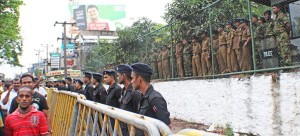 |
| Police in hundreds were deployed even to intimidate the funeral of the killed ( photo wsws) |
Bob Dietz/CPJ Asia Program Coordinator
Details are emerging of Sri Lanka’s effort to control media coverage of an ugly attack on demonstrators by security forces last week. In Rathupaswala village in the town of Weliweriya, outside Colombo, on August 1, soldiers beat and fired on people protesting what they feared was contamination of their drinking water by a nearby factory. Most media accounts say three people died and 50 were wounded (here is AP and AFP coverage). Journalists, reports say, were singled out.
Local journalists’ support group Free Media Movement, in an email statement the day after the attack, said, “It is very clear that military crackdown has been pre-planned and not a spontaneous reaction. The army has launched military operation-style coordinated attacks from three main points using assault rifles.”
Because of military pressure on the media at the time, there was little photo or video coverage of the actual shooting, only eyewitness accounts. There are Sinhala interviews on YouTube. Despite official efforts to downplay the violence, criticism of the government is bubbling up. Bishop Maxwell Silva, auxiliary bishop of the Archdiocese of Colombo, condemned the killings at Wednesday’s memorial service for one of the youth who died. “The Armed Forces have gone beyond the assigned responsibilities to cause the death of this student Ravishan and two others. These are innocent children who were seeking refuge in the church and in a safe place, while shooting was going,” Silva said, according to the Sri Lankan Catholics Facebook page.
Too big to be ignored altogether, the attack was reported in Sri Lankan pro-government papers initially in short items. The Nation, for instance, reported in a 149-word article that “One person succumbed to his injuries” and at least 10 were hospitalized following clashes between protesters, security forces, and police. The paper made no mention of gunfire, only water cannon and tear gas.
More independent papers like Ceylon Today gave it greater coverage, as in this eyewitness article headlined “Brute force used against scribes:”
On Thursday, before the army turned its guns on the public, a senior military official, who was commanding the troops there, delivered a stern message to the media crews, which had been covering the protest.
“Get out. Don’t take photos. You are not wanted here,” he said in an intimidating voice. The soldiers, armed to teeth, stood next to him. Hours later, a contingent of battle hardened troops, who once formed the ‘fabled’ 58 Division, went berserk in the town, killing one teenager and wounding 30 others.
Journalists, who refused to leave, later had to flee for their lives. Soldiers liberally took aim at them. Some soldiers later swapped rifles for clubs and went around thrashing the public. Journalists were clearly singled out, a female provincial correspondent hid on a roof to evade marauding soldiers. A photojournalist was assaulted and later hospitalized. The military confiscated the microchips. Cameras were smashed in the hullabaloo.
Journalists, who were at the scene said the attack on the press was clearly orchestrated. The army did not want to leave evidence–and soldiers had been ordered to take on the scribes and their cameras. The majority of the media crew at the scene was provincial correspondents, and was far more vulnerable to military intimidation.
The army says it will conduct an internal investigation into the deaths of three civilians from gunshot wounds. Opposition politicians are calling for an independent investigation. As independent website Groundviews pointed out, “Adding insult to injury, government spokespersons are also quoted as alleging foreign involvement in the event, political party sponsorship of the violence, and ascribing responsibility to the media.”
There are still independent voices in Sri Lanka, though the space for critical reporting has narrowed immensely. Comments like those from Groundviews and the Free Media Movement, which noted that “A democratic state is duty bound to protect peaceful protests, freedom of expression and journalists’ right to cover peoples’ campaigns,” are dangerous in the context of Sri Lanka’s record of unsolved murders and disappearances of journalists
International correspondents who travel to Colombo in November for the Commonwealth Heads of Government Meeting (assuming they will be allowed into the country) should make an effort to reach out to their colleagues under duress and report the pressures they face. In this case, the media in Sri Lanka are part of the story.
Bob Dietz, coordinator of CPJ’s Asia Program, has reported across the continent for news outlets such as CNN and Asiaweek. He has led numerous CPJ missions, including ones to Afghanistan, Pakistan, the Philippines, and Sri Lanka. Follow him on Twitter @cpjasia and Facebook @ CPJ Asia Desk
